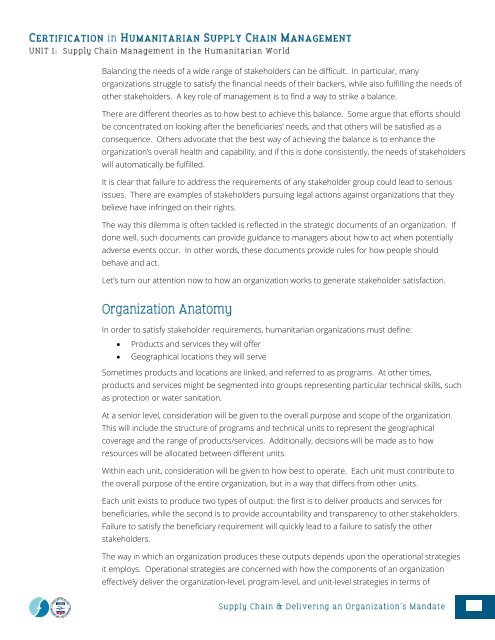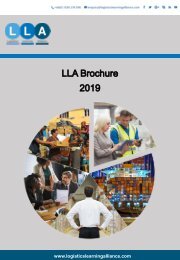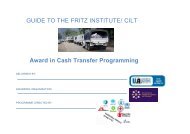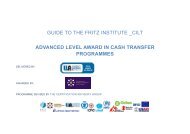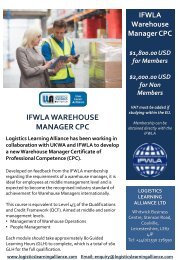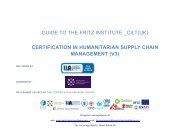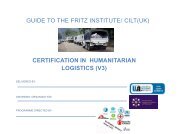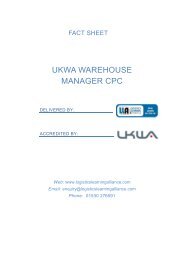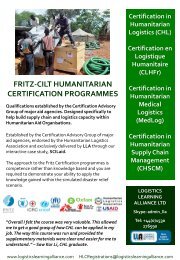CHSCM 3.0 - Unit 1 - SCM in the Humanitarian World
Learning Materials for Unit 1 of the Certification in Humanitarian Supply Chain Management (CHSCM).
Learning Materials for Unit 1 of the Certification in Humanitarian Supply Chain Management (CHSCM).
You also want an ePaper? Increase the reach of your titles
YUMPU automatically turns print PDFs into web optimized ePapers that Google loves.
Balanc<strong>in</strong>g <strong>the</strong> needs of a wide range of stakeholders can be difficult. In particular, many<br />
organizations struggle to satisfy <strong>the</strong> f<strong>in</strong>ancial needs of <strong>the</strong>ir backers, while also fulfill<strong>in</strong>g <strong>the</strong> needs of<br />
o<strong>the</strong>r stakeholders. A key role of management is to f<strong>in</strong>d a way to strike a balance.<br />
There are different <strong>the</strong>ories as to how best to achieve this balance. Some argue that efforts should<br />
be concentrated on look<strong>in</strong>g after <strong>the</strong> beneficiaries’ needs, and that o<strong>the</strong>rs will be satisfied as a<br />
consequence. O<strong>the</strong>rs advocate that <strong>the</strong> best way of achiev<strong>in</strong>g <strong>the</strong> balance is to enhance <strong>the</strong><br />
organization’s overall health and capability, and if this is done consistently, <strong>the</strong> needs of stakeholders<br />
will automatically be fulfilled.<br />
It is clear that failure to address <strong>the</strong> requirements of any stakeholder group could lead to serious<br />
issues. There are examples of stakeholders pursu<strong>in</strong>g legal actions aga<strong>in</strong>st organizations that <strong>the</strong>y<br />
believe have <strong>in</strong>fr<strong>in</strong>ged on <strong>the</strong>ir rights.<br />
The way this dilemma is often tackled is reflected <strong>in</strong> <strong>the</strong> strategic documents of an organization. If<br />
done well, such documents can provide guidance to managers about how to act when potentially<br />
adverse events occur. In o<strong>the</strong>r words, <strong>the</strong>se documents provide rules for how people should<br />
behave and act.<br />
Let’s turn our attention now to how an organization works to generate stakeholder satisfaction.<br />
In order to satisfy stakeholder requirements, humanitarian organizations must def<strong>in</strong>e:<br />
• Products and services <strong>the</strong>y will offer<br />
• Geographical locations <strong>the</strong>y will serve<br />
Sometimes products and locations are l<strong>in</strong>ked, and referred to as programs. At o<strong>the</strong>r times,<br />
products and services might be segmented <strong>in</strong>to groups represent<strong>in</strong>g particular technical skills, such<br />
as protection or water sanitation.<br />
At a senior level, consideration will be given to <strong>the</strong> overall purpose and scope of <strong>the</strong> organization.<br />
This will <strong>in</strong>clude <strong>the</strong> structure of programs and technical units to represent <strong>the</strong> geographical<br />
coverage and <strong>the</strong> range of products/services. Additionally, decisions will be made as to how<br />
resources will be allocated between different units.<br />
With<strong>in</strong> each unit, consideration will be given to how best to operate. Each unit must contribute to<br />
<strong>the</strong> overall purpose of <strong>the</strong> entire organization, but <strong>in</strong> a way that differs from o<strong>the</strong>r units.<br />
Each unit exists to produce two types of output: <strong>the</strong> first is to deliver products and services for<br />
beneficiaries, while <strong>the</strong> second is to provide accountability and transparency to o<strong>the</strong>r stakeholders.<br />
Failure to satisfy <strong>the</strong> beneficiary requirement will quickly lead to a failure to satisfy <strong>the</strong> o<strong>the</strong>r<br />
stakeholders.<br />
The way <strong>in</strong> which an organization produces <strong>the</strong>se outputs depends upon <strong>the</strong> operational strategies<br />
it employs. Operational strategies are concerned with how <strong>the</strong> components of an organization<br />
effectively deliver <strong>the</strong> organization-level, program-level, and unit-level strategies <strong>in</strong> terms of


